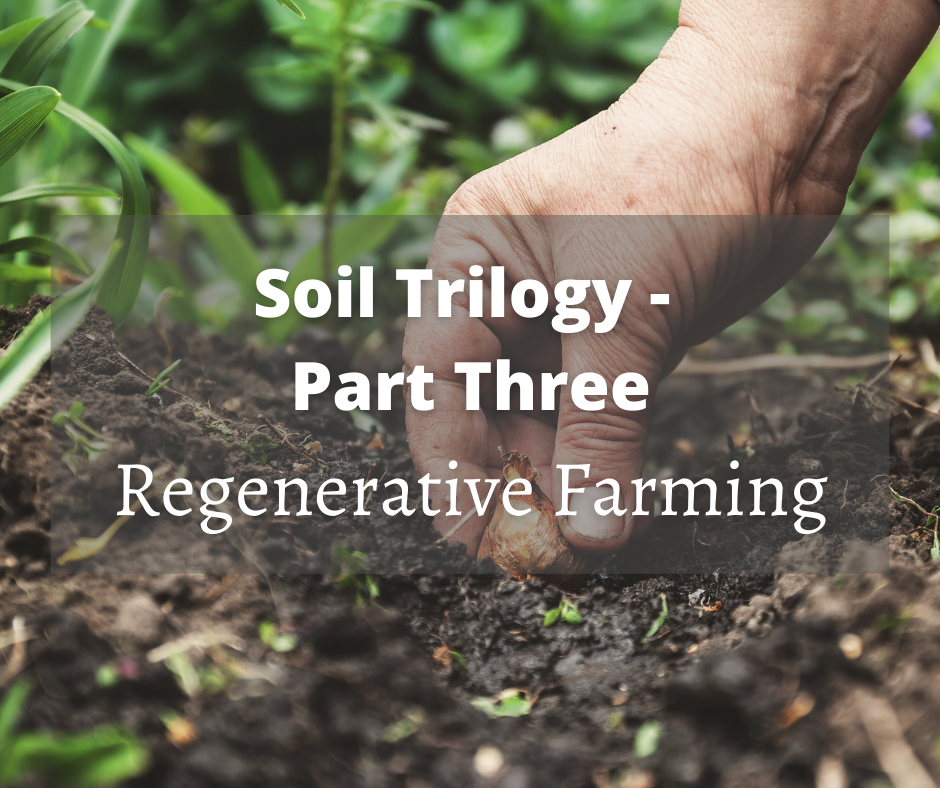
The Soil Trilogy - Part Three: Regenerative Farming
Regenerative agriculture in a nutshell
1. Low to no tilling

Image via Kiss the Ground
2. Diversifying crops

Regenerative ag rarely or never plants the same crop in the same spot twice in a row. By rotating crops throughout the field and planting radishes in a bed one season, beets in that spot the next, and so on, the soil receives a variety of beneficial nutrients. Just like we read in the previous blog, soil – like humans – benefits from a mixed diet, and feeds on the sugars released from crops. Having a variety of nutrients not only results in more productive growing soil, but it also guarantees greater nutrient-dense food for us! By restoring degraded soil biodiversity and creating a more complex ecosystem that encourages long-term fertility in the soil, we’re improving its quality while also maximizing the profitability of the soil.
3. Using Cover Crops
 Image via University of Madison - Wisconsin
Image via University of Madison - Wisconsin
4. Companion Planting

By strengthening the soil, it will naturally become more resistant to disease and pest problems but won’t eliminate them altogether. We want to keep beneficial insects in while keeping feasting pests out, and the cure for that is companion planting. Companion planting is using crop properties to naturally deter pests from other crops. For example, what eats carrots may be deterred by tomatoes, so it’s good to plant these side by side. It’s important to familiarize yourself with the chart linked above, as there are also things that shouldn’t be planted together, like rows and rows of kale and cabbage together, as the same pest can attack your entire crop, leaving you with no food and no profit. Companion planting will also help prevent the competition for nutrients, as carrots and tomatoes require vastly different nutrients to grow, and will help your crop grow to its full potential faster. Once again, companion planting takes a bit more planning up front, but the upkeep is easier as you won’t have to worry about mending or tending to infested crops or damaged soil from sprays.
5. Rotational grazing

Livestock always get a bad rep when it comes to climate change and methane release, but the key here is to get the cattle moving! If livestock stay on the same plot, they will eat the greenery through to the roots, leaving it with no chance to regrow. Regenerative ag practices “rotational grazing”, which encourages cattle to free-roam to another spot once they’re finished eating, and fencing them off from the previously grazed area. Free-roam gives the plants a chance to regrow, which is greatly possible because the livestock has fertilized it while grazing. This relationship is vastly misunderstood, and if you do use livestock on your property, there is a way to do it sustainably and in a way that helps rebuild soil and sequester (trap) carbon into the ground.
Regenerative agriculture at home

You don’t have to be a farmer to grow regeneratively right in your home or neighborhood! All of these practices can be applied to your home or community garden. Now that you know the principles to follow, you’re well equipped to start transitioning into regenerative planting! The key is to keep as much diversity in your garden as possible, and implementing trees and other large green spaces to draw down carbon from the atmosphere. As much as agriculture is a cause for climate change, it’s also a huge part of the solution. Regenerative agriculture shows us that it’s entirely possible to provide our booming population with fresh, healthy food, that’s also grown in a sustainable soil ecosystem. The main takeaway is that if we take care of the soil, the soil will take care of us.
Healthy soil leads to a healthy plant, which leads to a healthy human and a healthy climate.
Did you miss the first two posts in our Soil Trilogy series? Check out Part 1 where we explain how soil degradation occurs. In Part 2, we dive into the negative effects soil health has on human health.









